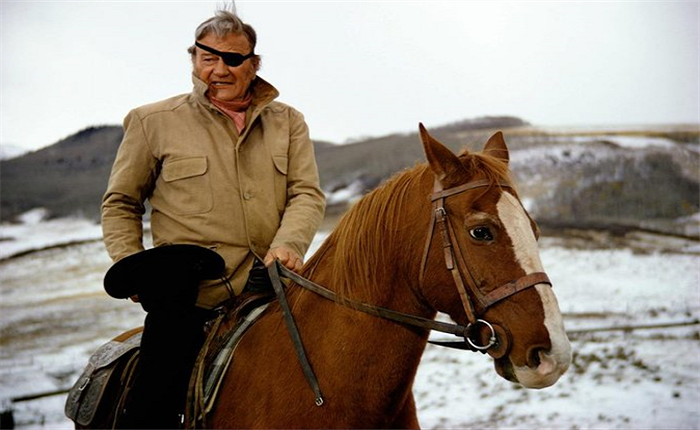The American actor, director, producer and cultural icon, John Wayne, is as much part of the myth of the old American West as a creaky saloon, a bouncing ball of tumbleweed and a cowboy on horseback doffing his hat to the local sheriff. Inextricably linked to the country’s quintessential genre of filmmaking, Wayne starred in over 150 movies over the course of half a century between 1926-1976, with his career covering the world war of the 1940s, the uprising of the civil rights movement in the 1960s and 1970s, and the end of the Vietnam conflict in 1975. For the better part of a century, Wayne had witnessed a country in significant political and social transition.
The son of an American Civil War veteran Marion Mitchell Morrison, Wayne grew up with a strong sentiment of national patriotism, excelling in sports and academic studies during his time at school, much like a model all-American student would. After applying to US Naval Academy but being refused for poor grades, he joined the University of Southern California and dipped his toes into the movie business for a favour to his football coach, Howard Jones.

Though he seems like an ethereal monolithic figure of American cinema, Wayne started his career like any other plucky young star, appearing as a prop boy and an extra in several movies throughout the late 1920s. He later found greater success in The Three Mesquiteers movies, an umbrella term used to describe a series of western B-movies, but it wasn’t until the veteran filmmaker John Ford cast the actor for his 1939 movie Stagecoach that his career would be spurred into action.
Winning two Oscars whilst also being nominated for ‘Best Picture’, Stagecoach became a critical and financial hit at the end of the 1930s, with Wayne emerging as an industry star seemingly overnight shortly before the start of the Second World War. Unable to enlist in the military due to his age and family status, a frustrated Wayne was forced to merely tour US bases and hospitals in the South Pacific between 1943 and 1944.
His lack of involvement in the war effort had a considerable impact on the actor’s mindset, with the widow of the actor, María del Pilar Pallete Alvarado, later stating: “He would become a ‘superpatriot’ for the rest of his life trying to atone for staying home”.

Although the lack of action had a considerable effect on Wayne’s psyche, it didn’t seem to sway the opinion of the American people, who celebrated the actor throughout the war and in the following years. Finding success with The High and the Mighty in 1954, Rio Bravo in 1959, The Alamo in 1960 and The Man Who Shot Liberty Valance in 1962, Wayne steadily grew an image of himself as a cold, stern bastion of American values, looking over each film he did as if he wasn’t a performer at all, but a sagacious omniscient overseer.
During this period, one of his most enduring performances came in the John Ford masterpiece The Searchers from 1956, in which the actor played Ethan Edwards, a powerful, complex character who was mentally fragile with the scars of his own contradictory, insidious racism. Playing an American Civil War veteran who sets out to save his niece from the clutches of the Comanches, Wayne’s Edwards sets out on a personal conquest punctuated by self-discovery.
“We had grown-up on Ford Apache, She Wore a Yellow Ribbon, Rio Grande, and kindly John Wayne characters. But here it was 1956, the repression of the ‘50s and things were changing,” filmmaker Martin Scorsese said of the era in which the Civil Rights movement was in its formative years of development. “These films are coming out and they’re showing this underbelly of the American psyche at that time”.

Continuing, he states: “He literally acts out the worst aspects of racism in our country, it’s right there. You can see the hate. And you can also see how he could go that way”. Voicing a tirade against the Native Americans throughout the movie, his hatred is illustrated in one scene where he robs a Comanche of his entrance to the afterlife, shooting out his eyes in a vindictive act that mocks and ridicules their religion and beliefs. “He just shows us the worst part of ourselves that is coming out of the late ‘40s, early ‘50s,” Scorsese adds, “He just brings it right up to the surface, so that we have to deal with it”.
In the end, Ethan rescues his niece, arriving on his own at the homestead of his family, clutching his arm as a lonely, vulnerable victim of the harsh wild west. Uncomfortable and ashamed, Wayne’s character retreats back to the barren wastelands in the film’s iconic final scene, trundling away as if he is a piece of perpetual tumbleweed, a relic of old America, rolling through the wilderness.

Leave a Reply